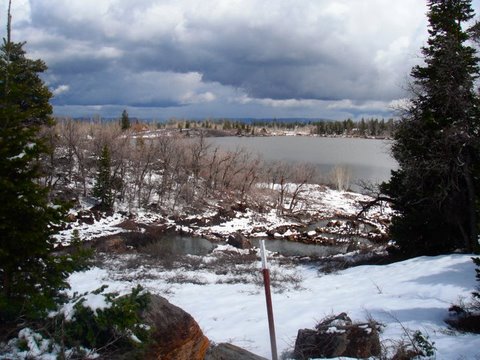The first few nights in Zion were very, very cold. With the rain falling, the temperatures dropped to the low 40s. A few students were cold at night, but once it was explained to them that the easiest solution was to layer on clothes, most slept okay. Even so, getting up in the morning before the sun was out meant facing the cold. Despite wearing most of my clothing, I was very cold most mornings (I slept well; I have a nice sleeping bag rated for 0 degrees F).
I was quite excited about our volunteering plans this day as we were helping with a scientific project. We drove to the Kolob Canyon entrance to Zion (the west side) and met up with a fire response team. A few years ago there was a fire on this side of the park that burned thousands of acres. While it was likely car brakes that started the fire, the real culprit is an invasive species called cheatgrass. The problem with cheatgrass, other than the fact that it crowds out native species, reducing bio-diversity, is that it grows quickly in the spring with the heavy rain, then dies in early summer, at the peak of fire season. The dry stalks that remain are like tinder just waiting to burn (and when they burn, they burn fast and hot).
Here’s a photo of the area where we were working:

While I’m not big into the whole “fight invasive species” movement (those battles will never be won), I am always interested in science. The goal of the project was to determine whether an herbicide treatment reduced the pervasiveness of the cheat grass. Basically, after the fire, some areas of the park were treated with an herbicide while others were not. In order to determine if the herbicide prevented cheatgrass growth, we counted cheatgrass stalks. The areas where we counted had already been plotted (this was started as a graduate student project). We simply had to lay down plastic squares at predetermined points and then count the number of stalks within those squares to get a sense of the density of the cheatgrass. Sometimes this was a breeze, as some spots were rocky or had other plants in them. Occasionally you’d put your plastic square over a very dense plot of cheatgrass and then you were in for some serious counting. In one spot my group counted 1,400 stalks of cheatgrass (the day’s record). Here we are counting in a lighter spot:

We helped on eight plots, which is two more than the fire crew is usually able to do in a day. We wrapped up around 2:30, then drove up the Kolob Canyon rode a ways. One of the students in our group had never seen snow (she’s from Florida and, smartly, has never left in the winter). The elevation was high enough that, instead of rain falling, it snowed on us. There was also snow still accumulated on the ground:

When we returned to our camp, it was time to start dinner. We had marinated chicken, baked potatoes, and corn – all cooked on the fire using aluminum foil:

After dinner we had another reflection and then called it a day.
![]()
Leave a Reply